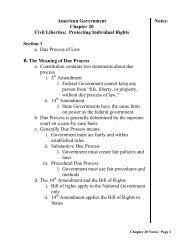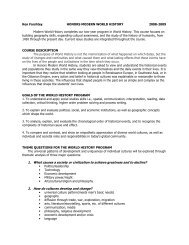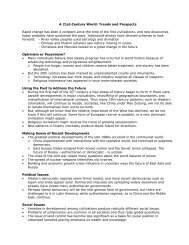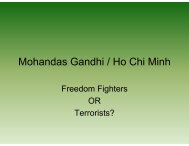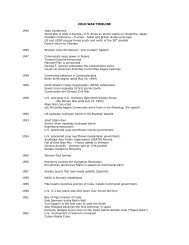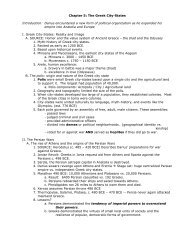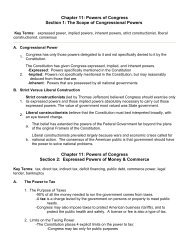AP WORLD HISTORY (in THREE PAGES??!!??)
AP WORLD HISTORY (in THREE PAGES??!!??)
AP WORLD HISTORY (in THREE PAGES??!!??)
Create successful ePaper yourself
Turn your PDF publications into a flip-book with our unique Google optimized e-Paper software.
<strong>AP</strong> <strong>WORLD</strong> <strong>HISTORY</strong> (<strong>in</strong> <strong>THREE</strong> <strong>PAGES</strong>??!!??)This course surveys approximately 10,000 years of world history, focus<strong>in</strong>g primarily on thelast 1000 years and the evolution of global processes and <strong>in</strong>teractions between and with<strong>in</strong>different human societies. The course is truly a global history rather than one focusedprimarily on Western civilizations with bits and pieces of others receiv<strong>in</strong>g only pass<strong>in</strong>gmention at best. While the acquisition of relevant factual knowledge is part of the course,the ma<strong>in</strong> focus is to develop critical and evaluative th<strong>in</strong>k<strong>in</strong>g skills and the ability to analyzeand <strong>in</strong>terpret historical documents <strong>in</strong> support of a plausible argument.UNIT 1: 8000 BCE - 600 CE (Foundations)Of all the time periods covered <strong>in</strong> the <strong>AP</strong> World History curriculum, Foundations spans thelargest number of years. It beg<strong>in</strong>s with an important Marker Event - the Neolithic /Agricultural Revolution / Transition - and ends after the fall of three major classicalcivilizations - Rome <strong>in</strong> the Mediterranean region, Han Ch<strong>in</strong>a, and the Gupta Empire of India.Broad topics addressed <strong>in</strong> the Foundations time period are:Environmental and periodization issuesEarly development <strong>in</strong> agriculture and technologyBasic cultural, political, and social features of early civilizations: Mesopotamia, Egypt,Indus Valley, Shang Ch<strong>in</strong>a, and Meso/South AmericaThe rise and fall of classical civilizations: Zhou and Han Ch<strong>in</strong>a, India (Gupta Empire),and Mediterranean civilizations (Greece and Rome)Major belief systems, <strong>in</strong>clud<strong>in</strong>g polytheism, H<strong>in</strong>duism, Judaism, Confucianism,Daoism, Buddhism, and ChristianityUNIT 2: 600 - 1450With the fall of the three major classical civilizations (Rome, Ch<strong>in</strong>ese Han, Indian Gupta),the stage was set for new trends that def<strong>in</strong>ed these years as another period with differentmigrations and conquests, and more developed trade patterns than before. Some majorevents and developments that characterized this era were:Older belief systems, such as Christianity, H<strong>in</strong>duism, Confucianism, and Buddhism,came to become more important than political organizations <strong>in</strong> def<strong>in</strong><strong>in</strong>g many areasof the world. Large religions covered huge areas of land, even though localizedsmaller religions rema<strong>in</strong>ed <strong>in</strong> place.Two nomadic groups - the Bedou<strong>in</strong>s and the Mongols - had a huge impact on thecourse of history dur<strong>in</strong>g this era.A new religion - Islam - began <strong>in</strong> the 7th century and spread rapidly throughout theMiddle East, Northern Africa, Europe, and Southeast Asia.Whereas Europe was not a major civilization area before 600 CE, by 1450 it wasconnected to major trade routes, and some of its k<strong>in</strong>gdoms were beg<strong>in</strong>n<strong>in</strong>g to assertworld power.Major empires developed <strong>in</strong> both South America (the Inca) and Mesoamerica (theMaya and Aztec.)Ch<strong>in</strong>a grew to have hegemony over many other areas of Asia and became one of thelargest and most prosperous empires of the time.Long distance trade cont<strong>in</strong>ued to develop along previous routes, but the amount andcomplexity of trade and contact <strong>in</strong>creased significantly.
UNIT 3: 1450 - 1750This era <strong>in</strong>cludes only 300 years, but some profound and long-last<strong>in</strong>g changesoccurred. Dur<strong>in</strong>g this period the two hemispheres were l<strong>in</strong>ked for the first time <strong>in</strong> worldhistory and long-distance trade became truly worldwide. Characteristics of the timeperiod <strong>in</strong>clude:The globe was encompassed - For the first time the western hemisphere came <strong>in</strong>tocont<strong>in</strong>ued contact with the eastern hemisphere. Technological <strong>in</strong>novations,strengthened political organization, and economic prosperity all contributed to thischange that completely altered world trade patterns.Sea-based trade rose <strong>in</strong> proportion to land-based trade - Technologicaladvancements and will<strong>in</strong>gness of political leaders to <strong>in</strong>vest <strong>in</strong> it meant that sea-basedtrade became much more important. As a result, old land-based empires lost relativepower to the new sea-based powers.European k<strong>in</strong>gdoms emerged that ga<strong>in</strong>ed world power - The relative power andprosperity of Europe <strong>in</strong>creased dramatically dur<strong>in</strong>g this time <strong>in</strong> comparison toempires <strong>in</strong> the longer-established civilization areas. However, Europe did not entirelyeclipse powerful empires <strong>in</strong> Southwest Asia, Africa, and East Asia.The relative power of nomadic groups decl<strong>in</strong>ed - Nomads cont<strong>in</strong>ued to play animportant role <strong>in</strong> trade and cultural diffusion, and they cont<strong>in</strong>ued to threaten theborders of the large land-based empires. However, their power dw<strong>in</strong>dled as traveland trade by water became more important.Labor systems were transformed - The acquisition of colonies <strong>in</strong> North and SouthAmerica led to major changes <strong>in</strong> labor systems. After many Amer<strong>in</strong>dians died fromdisease transmitted by contact with Europeans, a vigorous slave trade from Africabegan and cont<strong>in</strong>ued throughout most of the era. Slave labor became very importantall over the Americas. Other labor systems, such as the mita and encomienda <strong>in</strong>South America, were adapted from previous native traditions by the Spanish andPortuguese."Gunpowder Empires" emerged <strong>in</strong> the Middle East and Asia - Empires <strong>in</strong> oldercivilization areas ga<strong>in</strong>ed new strength from new technologies <strong>in</strong> weaponry. Bas<strong>in</strong>gtheir new power on "gunpowder," they still suffered from the old issues that hadplagued land-based empires for centuries: defense of borders, communication with<strong>in</strong>the empire, and ma<strong>in</strong>tenance of an army adequate to defend the large territory. Bythe end of the era, many were less powerful than the new sea-based k<strong>in</strong>gdoms ofEurope.UNIT 4: 1750 - 1914New ways of th<strong>in</strong>k<strong>in</strong>g cont<strong>in</strong>ued to develop and unfold <strong>in</strong> this era as profound social andpolitical change spurred revolution and the development of <strong>in</strong>dustrialized economicmight. Very important characteristics that dist<strong>in</strong>guish 1750-1914 from previous eras <strong>in</strong>world history <strong>in</strong>clude:Patterns of world trade and technology changed as the Industrial Revolutionrevolutionized communications and commerce.Huge numbers of people migrated to the Americas from Europe and Asia, so thatpopulation <strong>in</strong> the western hemisphere grew dramatically, lead<strong>in</strong>g eventually tothe end of the slave trade and forced migrations from Africa to the New World.
Industrialization had a huge impact on the environment, as demands for newfuels came about and cities dom<strong>in</strong>ated the landscape <strong>in</strong> <strong>in</strong>dustrialized countries.Less <strong>in</strong>dustrialized countries often supplied the demand for raw materials,alter<strong>in</strong>g natural landscapes further.Serf and slave systems became less common, but the gap between the rich andpoor grew <strong>in</strong> <strong>in</strong>dustrialized countries. Did women's status improve, or did gender<strong>in</strong>equality grow?Revolutions and <strong>in</strong>dependence movements transformed the political and sociallandscape of many parts of the word as direct result of 17th and 18th centuryEnlightenment philosophies tak<strong>in</strong>g hold, all lead<strong>in</strong>g to a develop<strong>in</strong>g sense ofnationalism.The def<strong>in</strong>ition of "west" expanded to <strong>in</strong>clude the United States and Australia, andwestern dom<strong>in</strong>ance reached not only economic and political areas, but extendedto social, cultural, and artistic realms as well.UNIT 5: 1914 - PresentWar and conflict def<strong>in</strong>ed this period as fragile alliances unraveled, giv<strong>in</strong>g way to<strong>in</strong>dependence movements across the world <strong>in</strong> the colonial hold<strong>in</strong>gs of former <strong>in</strong>dustrialpowerhouses, mov<strong>in</strong>g the world toward a new global culture. Major characteristics thatdist<strong>in</strong>guish the time period 1914 - present <strong>in</strong>clude:The 20th century was marked by conflict and diplomacy, witness<strong>in</strong>g two worldwars, and eventually a change <strong>in</strong> the nature of warfare with the Cold Warbetween the United States and the Soviet Union, lead<strong>in</strong>g to the proliferation of<strong>in</strong>ternational organizations to address the chang<strong>in</strong>g balance of power <strong>in</strong> theworld.Nationalism cont<strong>in</strong>ued to shape <strong>in</strong>teractions among nations as large empiresbroke <strong>in</strong>to smaller ethnic based countries, with widespread decolonization afterWorld War II both reflected and promoted via nationalism <strong>in</strong> former colonies.The Great Depression affected some countries more than others, but it had aprofound economic impact on both <strong>in</strong>dustrialized and non-<strong>in</strong>dustrialized areas aswell as on world trade. New technologies promoted economic development <strong>in</strong>Pacific Rim countries and contributed to the emerg<strong>in</strong>g importance ofmult<strong>in</strong>ational corporations.Revolutions shook Russia, Ch<strong>in</strong>a, and many Lat<strong>in</strong> American countries, lead<strong>in</strong>g toexperimentation with different versions of communism, socialism, and capitalism,with some turn<strong>in</strong>g to authoritarian methods and others to democracy.Social reform and revolution led to changes <strong>in</strong> gender roles, family structures,the rise of fem<strong>in</strong>ism, peasant protest, and <strong>in</strong>ternational Marxism.Massive movements of people to <strong>in</strong>dustrialized countries cont<strong>in</strong>ued to shape theworld while the environment was altered by cont<strong>in</strong>ued urbanization anddeforestation as significant green/environmental movements emerged to resistthe changes.




